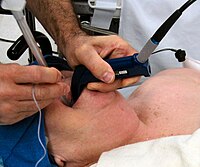
Photo from wikipedia
We thank El-Boghdadly et al. for their article reporting the incidence of coronavirus disease 2019 (COVID-19) in healthcare workers following tracheal intubation [1]. Their study found a 10.7% incidence of… Click to show full abstract
We thank El-Boghdadly et al. for their article reporting the incidence of coronavirus disease 2019 (COVID-19) in healthcare workers following tracheal intubation [1]. Their study found a 10.7% incidence of COVID-19 following tracheal intubation in patients with confirmed or suspected COVID-19. During the same period, we conducted a prospective service evaluation at our institution to assess laryngoscopists’ risk of COVID-19 acquisition. Our findings differed from those of El-Boghdadly et al. and so we present a summary of our service evaluation and a rationale for the differences. The service evaluation was registered with Imperial College Healthcare NHS Trust and data were collected prospectively from 11 March to 30 April 2020. Inclusion criteria were: patient age > 18 years; absence of a negative COVID-19 ribonucleic acid polymerase chain reaction (RNA-PCR) test; and tracheal intubation for any indication. Following tracheal intubation, a questionnaire was completed detailing the indication, COVID-19 status of the patient and the availability and usage of personal protective equipment (PPE). Questionnaire completion was mandatory. COVID-19 status was classified as ‘confirmed’ (RNA-PCR test positive), ‘suspected’ (fever or new persistent cough, no RNA-PCR test) or ‘unable to exclude’ (no fever or cough, no RNA-PCR test). Clinical data were extracted retrospectively from the electronic patient record. Laryngoscopist health 5, 10 and 14 days post-intubation was obtained from the electronic staff rota, and categorised as ‘healthy, at work’, ‘healthy, selfisolating’ (due to a household member with symptoms of COVID-19) or ‘sick, off work’. The first death in London from COVID-19 occurred on 12 March 2020 at our institution [2]. This, in addition to the deficiency in local stocks, spurred the development of a steering group to establish resilient supply chains for World Health Organization (WHO) standard PPE [3]. By 17 March, we had independently sourced PPE, including reusable respirators and visors and, by 24 March, had formalised infection control, cleaning protocols and training. Seventy-two patients’ tracheas were intubated during the data collection period. The most common indications were hypoxia (n = 34; 47%) and surgical operations (n = 20; 28%). A total of 24 (33%) intubations were performed in the emergency department, 20 (28%) on a general ward, 14 (19%) in the intensive care unit and 14
Journal Title: Anaesthesia
Year Published: 2020
Link to full text (if available)
Share on Social Media: Sign Up to like & get
recommendations!